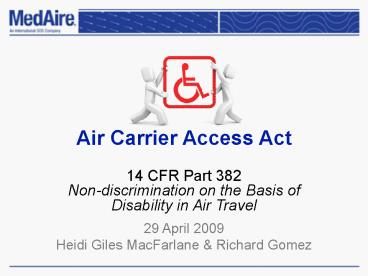Air Carrier Access Act - PowerPoint PPT Presentation
1 / 21
Title:
Air Carrier Access Act
Description:
Passengers with disabilities who are aware of the new rule ... Egregious cases. Maximum civil penalty for ACAA violations ($27,500 per violation) ... – PowerPoint PPT presentation
Number of Views:96
Avg rating:3.0/5.0
Title: Air Carrier Access Act
1
Air Carrier Access Act
14 CFR Part 382 Non-discrimination on the Basis
of Disability in Air Travel
29 April 2009 Heidi Giles MacFarlane Richard
Gomez
2
Todays Discussion
- The ACAA Rule
- What to Expect from the DOT on May 13
- Importance of Training
- Respiratory Assistive Devices
3
14 CFR Part 382
- Effective May 13, 2009 no air carrier may
discriminate against any otherwise qualified
individualwith a disability - U.S. Department of Transportation (DOT)
4
The ACAA Rule
- EFFECTIVE 13 MAY 2009
5
(No Transcript)
6
How MedAire Complies
- Closely monitor regulations worldwide
- Respond to medical-related NPRMs
- Understand and comply with regulations
- Help airlines mitigate medical risk
7
What to Expect
- More passengers with unique needs
- Passengers with disabilities who are aware of the
new rule - Affected persons who may file a complaint
- Monitoring by the DOT
- Inspections and potential fines
8
What to Expect from the DOT
9
Compliance Activities
- Role of DOTs Office of the Assistant General
Counsel for Aviation Enforcement and Proceedings - Attend and review CRO training classes offered by
U.S. and foreign carriers - Purpose of review
- Use compliance reviews to address problems
encountered by persons with disabilities when
they travel
10
Enforcement
- Pursue enforcement action based on
- Pattern and practice of discrimination
- Egregious cases
- Maximum civil penalty for ACAA violations
(27,500 per violation) - Committed to ensuring carrier compliance
- Working with airlines to achieve the common goal
of accessibility in air travel.
11
382.141
- Train to proficiency
- General understanding of the rule
- Knowledge of procedures
- Knowledge to safely operate equipment
- Ability to respond to requests
- Consult with disability advocacy groups
- Ensure contractors provide adequate training
12
(No Transcript)
13
Develop a Training Plan
14
Respiratory DevicesUse Must be Allowed on
Aircraft
- CPAP-Continuous positive airway pressure device
- POC- Portable oxygen concentrator
- VENT-Respirator / Ventilator
Aircraft with 19 or more passengers
15
Why these Devices?
- Common denominator chronic medical conditions
- Sleep apnea affects 18 million
- Chronic obstructive pulmonary disease (COPD)
affects 16 million - Congestive heart failure (CHF) affects 4.8
million - Neuromuscular / musculoskeletal disorders
- In-flight risk is relative to dependency on the
device
Statistics are for people in the United States
16
Continuous Positive Airway Pressure Devices
- CPAPs
- Used commonly to treat sleep apnea
- Delivered via a face mask
- Eases breathing by opening the airways during
sleep - Low risk use on board
In the event of a decompression, users will need
to use the drop down masks
17
Portable Oxygen Concentrators
- Treats low oxygen levels in the blood (COPD,
CHF) - Settings to be based on altitude
- Risk during depressurization
- Power supply depletion
- Alternatives during device failure (emergency
oxygen bottle)
Seven POC devices are approved by the Federal
Aviation Administration
18
Respirators/Ventilators
- Breathes for someone who cant breathe by
themselves - Usually devices is connected by tube in neck
(tracheostomy) - Risk during depressurization
- Power supply depletion
- Device failure requires manual ventilation
19
An Airlines Responsibility
- Training on these devices is not required
- However, you should
- Recognize approved devices
- Understand criteria for acceptance
- Know how and why assistive devices are used
- Be comfortable
- Implement normal and non-normal emergency
procedures
20
In Conclusion
- To enhance access to the skies
- Read the rule know what to expect
- Share your plan with the DOT
- Educate your workgroups to proficiency
- Integrate respiratory assistive devices into your
current procedures
21
For Further Questions
Contact Heidi Giles MacFarlane heidi.giles_at_MedAir
e.com OR VISIT BOOTH 228

